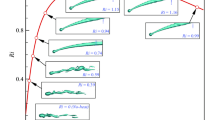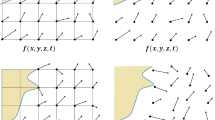Abstract
The goal of the review is to acquaint experts in combustion and explosion with the method of cellular automata, also called the lattice-gas method, a comparatively new approach to modeling of gas-dynamic processes. The motion of a continuous medium is modeled directly by calculating the evolution of a special microworld of particles, which move in a fixed two- or three-dimensional lattice and collide with each other at the lattice sites. In essence, what is involved is the most simplified version of molecular dynamics. Examples are given of application to various problems, including calculation of reacting flows, unstable problems, and flows in a complex geometry. Possible applications of the method in the physics of combustion and explosion are discussed.
Similar content being viewed by others
Literature Cited
U. Frish, B. Hasslacher, and Y. Pomeau, “Lattice-gas automata for the Navier-Stokes equation,” Phys. Rev. Lett.,56, No. 14, 1505 (1986).
H. Hardy, O. de Pazzis, and Y. Pomeau, “Molecular dynamics of a classical lattice gas: transport properties and time correlation functions,” Phys. Rev. A13, No. 5, 1949 (1976).
S. Wolfram, “Cellular automaton fluids. 1: Basic theory,” J. Stat Phys.,5, No. 3/4, 471 (1986).
T. Toffoli and N. Margolus, “Cellular automata supercomputers for fluid-dynamics modeling,” Phys. Rev. Lett.,56, No. 16, 1694 (1986).
J.-P. Rivet, M. Hénon, U. Frish, and D. D'Himières, “Simulating fully three-dimensional flow by lattice-gas methods,” Europhys. Lett.,7 (3), 231 (1988).
J. P. Dahlburg, D. Montgomery, and G. D. Doolen, “Noise and compressibility in lattice-gas fluids,” Phys. Rev. A36, No. 5, 2471 (1987).
G. Zanetti, “The hydrodynamics of lattice gas automata,” Phys. Rev. A40, 1539 (1989).
“Bibiography for NATO workshop on lattice gas methods for PDE's: theory, applications and hardware,” Physica D,47, 299 (1991).
A. K. Gunstensen and D. A. Rotman. “A Galilean-invariant immiscible lattice gas,” Physica D,47 53 (1991).
S. Chen, H. Chen, G. D. Doolen, et al., “Lattice gas models for nonideal gas fluids,” Physica D,47, 97 (1991).
A. K. Gunstensen and D. A. Rotman, “A lattice-gas model for three immiscible fluids,” Physica D,47 (1991).
P. Clavin, P. Lallemand, Y. Pomeau, and G. Searby, “Simulation of free boundaries in flow systems by lattice-gas model,” J. Fluid Mech.,188, 437 (1988).
S. Chen, K. Diemer, G. D. Doolen, et al., “Lattice gas automata for flow through porous media,” Physica D,47, 72 (1991).
F. Hayot. “Fingering instability in a lattice gas,” Physica D,164 (1991).
J. T. Wells, D. R. Janesku, and B. J. Travis “A lattice gas automata model for heterogeneous chemical reactions at mineral surfaces and in pore networks,” Physica D,47, 115 (1991).
H. Chen, S. Chen, and G. D. Doolen, “Sound wave propagation in FHP lattice gas automata,” Phys. Lett. A,140, No. 4, 161 (1989).
S. Chen, H. Chen, and G. D. Doolen, “How the lattice gas model for the Navier-Stokes equation improves when a new speed is added,” Complex Systems,3, 243 (1989).
D. Rernardin, O. E. Sero-Guillaume, and C. H. Sun, “Multispecies 2D lattice gas with energy levels: diffusive properties,” Physica D,47, 169 (1991).
S. Chen, M. Lee, K. H. Zhao, and G. D. Doolen, “A lattice gas model with temperature,” Physica D,47, 42 (1991).
Additional information
M. A. Lavrent'ev Institute of Hydrodynamics, Siberian Branch, Russian Academy of Sciences, Novosibirsk, 630090. Translated from Fizika Goreniya i Vzryva, Vol. 30, No. 1, pp. 107–117, January–February, 1994.
Rights and permissions
About this article
Cite this article
Ershov, A.P. Gas dynamics of cellular automata (review). Combust Explos Shock Waves 30, 107–116 (1994). https://doi.org/10.1007/BF00787893
Issue Date:
DOI: https://doi.org/10.1007/BF00787893




